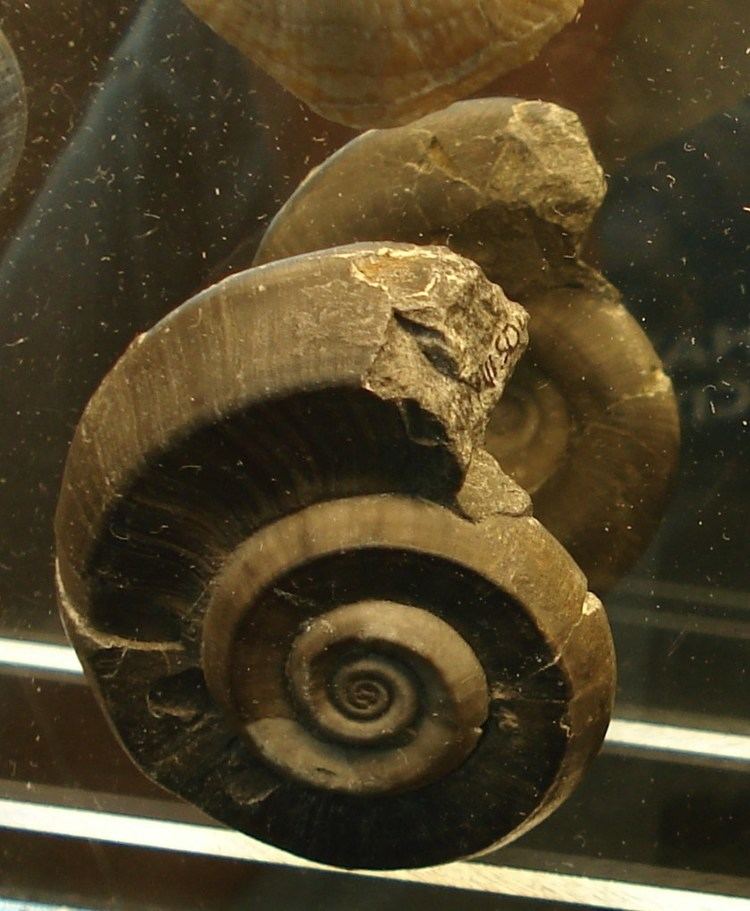Rank Superfamily | ||
 | ||
People also search for Macluritoidea, Euomphalidae | ||
Euomphaloidea, originally Euomphalacea, is an extinct superfamily of marine molluscs that lived from the Early Ordovician to the Late Cretaceous, included in the Gastropoda but speculated as instead perhaps Monoplacophora.
Contents
Description
Euomphaloid shells are mostly discoidal and may be either orthostrophic (coils wrapped around an erect cone) or hyperstrophic (coils wrapped around an inverted cone); are widely umbilicate and commonly have a channel, presumed exhalent, within the angulation in the outer part of the upper whorl surface. The shell wall is relatively thick, with an external prismatic layer of calcite, which may be pigmented, and an internal layer of lamellar, but not nacreous, aragonite.
Taxonomy
As with almost all fossils, the taxonomic relations of and within the euophaloids can only be inferred from their remaining hard parts, in their case the shell. The general inclusion of the Euomphalacea, as originally spelled is based on the asymmetrically coiled tubular shell, suggestive if not indicative of the diagnostic torsion.
Taxonomy of the Treatise 1960
J. Brooks Knight, et al, 1960, in the Treatise on Invertebrate Paleontology, Part I, included the Euomphalacea, as then used, in the suborder Macluritina, deriving them from the Macluritacea, and included the following three families.
Prior to, R.C. Moore in 1952, included the Euomphalacea in the gastropod order Archaeogastropoda.
More recent taxonomies
The Euomphaloidea are included in the gastropod order Euomphalina, subclass Eogastropoda (revised Prosobranchia) according to Ponder & Lindberg (1997)Taxonomy of the Gastropoda (Ponder & Lindberg, 1997). This was accepted by Wagner, (2008) revised to include the following families.
Anomphalidae Wenz, 1938Elasmonematidae Knight, 1956Euomphalidae de Koninck, 1881Helicotomidae Wenz, 1938Holopeidae Wenz, 1938Lesueurillidae Wagner, 1999Microdomatidae Wenz, 1938Omphalocirridae Wenz, 1938Omphalotrochidae Knight, 1945Pseudophoridae Miller, 1889Raphistomatidae Koken, 1896Tychobraheidae Horný, 1992 (excludes Tychobrahea)In the meantime Boucet and Rocroi (2005)Taxonomy of the Gastropoda (Bouchet & Rocroi, 2005) classified the Eumphaloidea simply as Paleozoic molluscs with anisostrophically coiled shells of uncertain position that are possibly gastropods, recognizing only five families, the:
Discussion, revised taxonomy
Prior to being included in the Euomphaloidea, the Anomphalidae, Elasmonematidae, Holopeidae, and Microdomatidae were included in the suborder Trochina, Cox & Knight 1960; the Anomphalidae in the Anomphalacea, the Elasmonematidae and Microdomatidae in the Microdomatacea, and the Holopeidae in the Plytyceratacea. The Raphystomatidae were included in the Pleurotomaracea, Pleurotomarina.
Omphalocirrus is included in the Maclurridae in the Treatise, 1960, but Lioomphalus, given as also in the Omphalocerridae is a synonym for Euomphalus, Euomphalidae,
